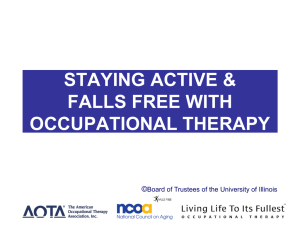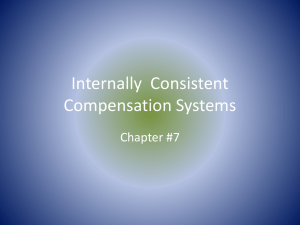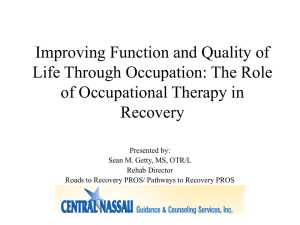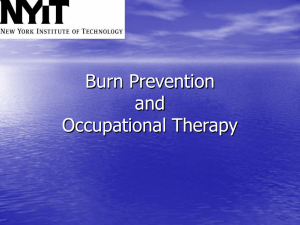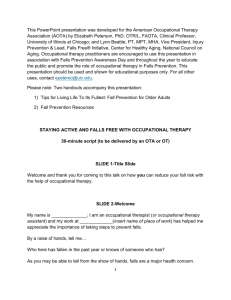30 minute Falls Prevention PowerPoint Presentation
advertisement
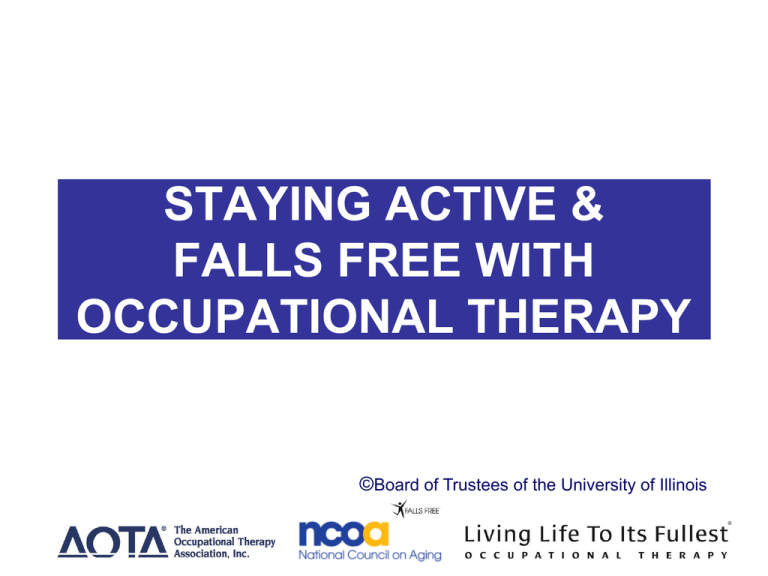
STAYING ACTIVE AND STAYING ACTIVE & FALLS FREE WITH OCCUPATIONAL THERAPY Header ©Board of Trustees of the University of Illinois WELCOME AND INTRODUCTION • Today’s presenter – Speaker inserts name, credentials and contact information here. PRESENTATION GOALS • By the end of this presentation, you will be able to: • Recognize that most falls among older adults result from interacting risk factors • Describe how occupational therapy practitioners can help you reduce your risk of falls • Identify strategies and resources that you can use to reduce your risk for falls WHY DO FALLS HAPPEN? TYPES OF FALL RISK FACTORS Most falls experienced by older adults result from interacting risk factors • Physical risk factors: Changes in your body that increase your risk for a fall • Behavioral risk factors: Things we do or don’t do that increase our fall risk • Environmental risk factors: Hazards in our home or community INTERACTING RISK FACTORS • What are environmental risk factors? • What are behavioral risk factors? Photograph courtesy of the UIC Dept. of Occupational Therapy Take a look at this scene: MINIMIZING RISK FACTORS WHAT IS OCCUPATIONAL THERAPY? ABOUT OCCUPATIONAL THERAPY Occupational therapy practitioners: • Help people of every age do the things they want and need to do through the therapeutic use of everyday activities • Focus on daily activities to help people remain as independent as possible despite injury, illness, or disability ABOUT OCCUPATIONS • The term “occupation” refers to a person’s involvement in meaningful activities. • For many, “occupations” are linked to important life roles and reflect our values and identities. OCCUPATIONAL THERAPY SETTINGS Photographs courtesy of the UIC Dept. of Occupational Therapy REHABILITATION HOSPITAL-BASED OCCUPATIONAL THERAPY Photograph courtesy of the UIC Dept. of Occupational Therapy HOME AND COMMUNITY BASED OCCUPATIONAL THERAPY Photographs courtesy of the UIC Dept. of Occupational Therapy Photograph courtesy of MaineHealth TEAMWORK IN OCCUPATIONAL THERAPY • A team approach is particularly important when it comes to preventing falls! THE ROLE OF OCCUPATIONAL THERAPY IN FALL PREVENTION • Occupational therapy practitioners teach people who are at risk for falls how to safely do things that are important to them. THE ROLE OF OCCUPATIONAL THERAPY IN FALL PREVENTION • Occupational therapy practitioners work with people after a fall-related injury to help them return to the things they need and want to do. Photograph courtesy of the UIC Dept. of Occupational Therapy CASE EXAMPLE: TERRY • Terry fractured his right wrist. • Terry’s doctor referred him to occupational therapy. Photograph courtesy of the UIC Dept. of Occupational Therapy • Terry fell while carrying a lawn chair down the steps to his basement. TERRY’S EVALUATION AND OCCUPATIONAL THERAPY PLAN • Kate and Terry worked together to create a plan to help him continue doing his daily activities and reduce his risk of future falls. Photograph courtesy of the UIC Dept. of Occupational Therapy • The occupational therapist completed a thorough evaluation. TERRY’S PHYSICAL RISK FACTORS: MEDICATIONS • Medications can interact and create health problems that increase falls risk. • Speak with your doctor about medications and how they make you feel. • Stay hydrated TERRY’S PHYSICAL RISK FACTORS: VISION • Have your vision checked regularly by an eye doctor. • Make sure that your home has adequate lighting that is within reach. ©AOTA 2013 TERRY’S PHYSICAL RISK FACTORS: BALANCE • Get involved in communitybased exercise programs for balance. Photograph courtesy of the UIC Dept. of Occupational Therapy • Occupational therapy practitioners can help you learn balance exercise and ways to safely build balance skills during day-to-day activities. TERRY’S ENVIRONMENTAL RISK FACTORS: FALL HAZARDS • Addressing fall hazards in the home. TERRY’S ENVIRONMENTAL RISK FACTORS: FALL HAZARDS • An occupational therapy home safety assessment involves carefully assessing a person’s ability & determining whether the home environment fits the person and promotes independence. TERRYS BEHAVIORAL RISK FACTORS • Occupational therapy practitioners can help you problem solve how to safely do the occupations or activities that are meaningful to you. TERRY’S BEHAVIORAL RISK FACTORS • What are alternative ways that you think Terry could have used to get the patio furniture inside without putting him at risk for a fall? TERRY’S BEHAVIORAL RISK FACTORS – Picking activities that are a good match for your capabilities Photograph courtesy of the UIC Dept. of Occupational Therapy • Fall prevention behaviors SUMMARY OF TERRY’S OCCUPATIONAL THERAPY PROGRAM • The program focused on: – Medication – Balance – Vision – Fall hazards in the home – Terry’s valued roles and occupations – Fall prevention behaviors FALL PREVENTION REFLECTION • What might you do or what have you done in the past to protect yourself from falls? • Do you have tips to share that we haven’t covered? SUMMARY OF STRATEGIES TO REDUCE FALLS RISK – Manage chronic illnesses or conditions – Get an eye exam regularly – Stay hydrated – Talk to physicians and pharmacists about medications – Stay active and exercise regularly – Find alternatives for potentially risky behaviors – Identify and eliminate fall hazards in the home CONCLUSION • Remember… – Falls can be prevented – Take charge of your health and utilize your resources ACKNOWLEDGEMENT OF AUTHORS Elizabeth W. Peterson, PhD, OTR/L, FAOTA Clinical Professor Director of Professional Education University of Illinois at Chicago (Bonita) Lynn Beattie, PT, MPT, MHA Vice President, Injury Prevention Lead, Falls Free Initiative Center for Healthy Aging National Council on Aging ©Board of Trustees of the University of Illinois

